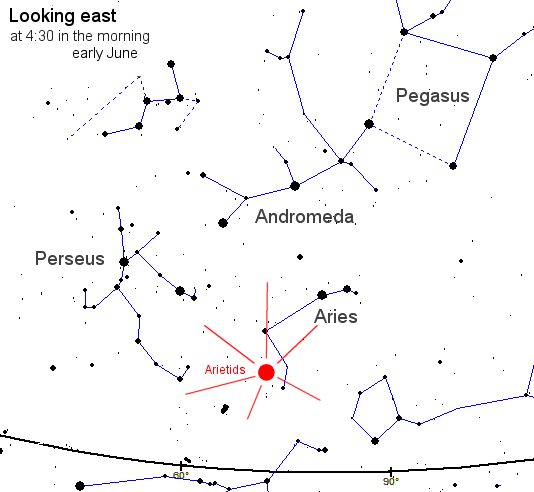Daylight
Meteors: The Arietids
back
to spaceweather.com
- The Arietid meteor shower is the strongest
daylight shower of the year. It lasts from late May until early July,
and peaks on June 7th.
- Arietid meteors stream out of the constellation
Aries; their source is unknown, although some astronomers suspect
they come from the sungrazing asteroid Icarus.
- Arietid meteoroids hit Earth's atmosphere
with a velocity of 39 km/s (87,000 mph).
 Every
year in early June thousands of meteors streak across the sky. Most
are invisible, though, because the Sun is above the horizon while the
shower is most intense. These daylight meteors are called the
Arietids. They stream from a radiant point in the constellation
Aries, which lies just 30 degrees from the Sun in June. No one is sure
where Arietid meteoroids come from, although some astronomers suspect
they are debris from the sungrazing asteroid 1566
Icarus. Another possibility is that the Arietids come from the breakup of a giant comet thousands of years ago. Every
year in early June thousands of meteors streak across the sky. Most
are invisible, though, because the Sun is above the horizon while the
shower is most intense. These daylight meteors are called the
Arietids. They stream from a radiant point in the constellation
Aries, which lies just 30 degrees from the Sun in June. No one is sure
where Arietid meteoroids come from, although some astronomers suspect
they are debris from the sungrazing asteroid 1566
Icarus. Another possibility is that the Arietids come from the breakup of a giant comet thousands of years ago.
Above: "Hey Joe, what was that?" A fanciful view of a daylight
Arietid fireball, by artist Duane Hilton. Bright sunlight renders most
Arietids invisible.
If you want to see a few Arietids, try looking just before sunrise.
The Arietid radiant rises in the east about 45 minutes before the sun.
(This is true for observers in both of Earth's hemispheres, north
and south.) Pre-dawn
Arietids tend to be "Earthgrazers"--meteors that skim horizontally
through the upper atmosphere from radiants near the horizon. Spectacular
Earthgrazers are usually slow and bright, streaking far across the sky--worth
waking up for!

Above: This image shows the area of sky around the Arietid radiant
(indicated by a red dot) as seen from mid-northern latitudes at 4 a.m.
on June 8th. A
southern hemisphere map
is available, too.
|

 Every
year in early June thousands of meteors streak across the sky. Most
are invisible, though, because the Sun is above the horizon while the
shower is most intense. These daylight meteors are called
Every
year in early June thousands of meteors streak across the sky. Most
are invisible, though, because the Sun is above the horizon while the
shower is most intense. These daylight meteors are called